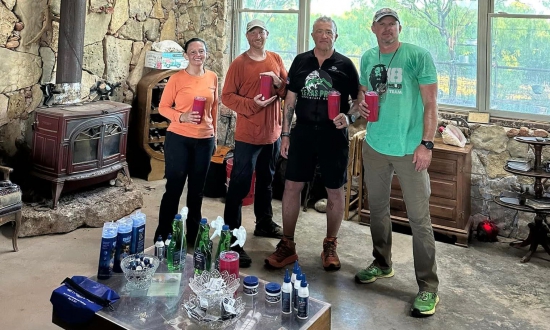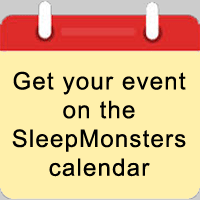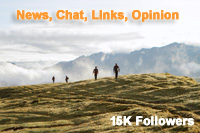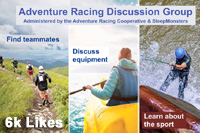Texas Pride and Teamwork
Matt Deylius / 04.05.2023


I was a very late addition to joining Texas Pride as a 4th team member along with Paul Ryan Kimberly Stewart and JT Korssjöen. Had I read the race director’s notes (Leiza Morales) on the race, “I can verify the mesquite thorns are sharp and almost all things stick, prick, sting or bite out here” I may have reconsidered and missed out on one of the best-designed team-orientated/team-building races I’ve experienced.
What do I mean by team-oriented races? The race caters to team building, helping you identify strengths and weaknesses, rewards team communication (especially in navigation), and provides several risk-based decisions with impactful rewards and harsh consequences (lots of time saved if everything works out, possible extreme discomfort if it doesn’t).
I’ll start with the Personal Accountability Model (think this is what it was called) - Basically, as few required items as possible from the race director's standpoint. It’s up to the individual and team to cover what will be needed. I’m telling you, I was grinning from ear to ear thinking how light and fast I was going to race. Uh oh, if everyone takes this “glass-cannon” approach, someone is bound to shatter.
A little bit of research and talking with the team about the race, and you start to realize that this is a race where almost all things are going to…well… stick, prick, sting or bite out there…sigh, med kit is in the pack. Then you check the weather and realize that a 42-degree and windy paddle in the AM with high 70s under the sun in the PM is going to require a layering strategy. Slowly but surely, the pack is filling up.
I wasn’t as full of gear as other races, but I wasn’t as light as I originally thought I’d be, and to be honest, there is absolutely nothing wrong with a heavier set of required gear from other races, it was just a great team exercise to _have_ to consider all the options and live with your choices. You can learn a lot about your team and their thought process as you learn what gear choices they feel are the bare minimum when given the opportunity.
Moving to limited race information, we were told there would be several stages. We didn’t know how many stages, how many CPs at each stage there would be, or if any CPs at certain stages would be worth more than others. When the race clock started, we received the coordinates for the first stage (a 4 CP trekking stage). Plot or go? Or Plot on the go…better decide quickly, teams are already off running. We plotted.
Pausing for a second to talk about the team building concept I mentioned earlier - after plotting, and in consideration of the accountability model, it would have been important to inform the team of the expected distance and rough time frame away from the TA to ensure we were packed accordingly (we had our TA gear accessible here to make changes). We didn’t have the conversation, but we were not punished as it was a short leg where navigation turned out to be more important than speed. We hit the first CP slower than other teams but finished the stage fast after solid navigation/route choices.
The second stage was a bike/paddle/trek. Bike to the boat launch, get some lake CPs, and get off the boats somewhere on the opposite side of the lake for some trekking CPs, then back into the boat to the boat launch, and finish the stage with the bike back to the TA. We did communicate about the stage details and decided how we wanted to tackle being cold off the lake, some brought extra layers to have at the boat launch, and some were willing to grit it out to the TA. Spoiler alert: I begged team members to let me tow them back on the bike to generate some extra heat.
There were no bike CPs in route, so we plotted one of the lake CPs and assumed too much, which would cost us later. We got to the far lake CP and got off the boat near the far end of the lake for the trekking CPs that we would finish plotting once off the boat. It was later that we realized two mistakes.
Mistake 1: One of the other lake CPs was a guide rail we went right by to ensure we were on the right path to get to the first far lake CP. Not only was this a wasted effort going back to that CP, but the wind was in high gear when we went to get it after the trek, making every paddle stroke a miserable one. Looking back, we should have cleared all the lake CPs first thing before the wind kicked up.
Mistake 2 was that we departed the boats on the far side of the lake to get out and trek… again when there was no wind on the lake. We should have paddled as much as possible without the wind, leaving the shortest paddle distance possible for when the wind (we did expect wind at some point) came. Oops, mistakes to learn from for future events. How much did being in the lead at the start of the paddle and wanting to keep a good lead have to do with these bad decisions? It clearly did in our case, some of these seem too obvious to miss had we paused to think about it. Race positions were lost.
Stage 3 was a bike/trek. We rode to a bike drop and had to trek a fairly large spread of land and ended back at the bike drop to bike back to the TA. Coming off the lake, and team members needing a little more time to adjust to the warmer conditions upcoming, we plotted at the TA. In this section, I want to compliment the race directors for what I thought were expertly placed CPs with wide-open route choices for teams to make.
Back to where I think this race is excellent for team building is what you can learn as a team about the route choices you take and how you can improve. One example of expertly placed CPs is taking an attack point from the low point on a road that was also part of the draw a CP was in. By this point in the day, it’s a little easier to start to slack with your pace counting. If you short-changed your pace counting, it would seem like you hit your mark but no CP was in sight, the draw also seemed to close up by overgrowth. How many people on the team pace counted? Did everyone signal where they thought they hit certain distances to gauge how disciplined everyone was being?
In recognizing this in ourselves, we were able to own up to being lazy and put the right pep in our step to find the CPs at the right distances. The overgrowth along with being worn down were great distractions to make you consider if you were in the wrong location or plotted incorrectly. Well played RD! Many of the CPs would reward or punish you for your ability to find the optimal attack points and pace count with discipline. Land features and overgrowth would cloud your judgement. Other CPs simply took you to amazing views to soak in.
Route choices gave teams the option to take longer but safer routes along dirt roads or routes that included shorter, but riskier choices through cactus patches and all things that want to stab or bite you. We had to figure out if our team could handle the longer but safer trek from a time perspective or if we had to take some risks to shorten the distance and time to get to our attack points. Risks were realized and med kits were used, luckily just for the stabby things, not the biting things.
One CP ended up eluding us, and maybe pride got in the way, but we spent too much time looking for it. Ultimately causing us to forfeit the unknown stages ahead of us. It turns out there was only one more stage, but it was a short bike stage that was rich in CPs. It was a fun race but an important one. Being treated to a baked potato spread before the race and a steak dinner following the race put the experience over the top. So glad I came out.
Yes yes yes, many races have similar risk/reward and team-building concepts I mention. I’m probably not giving this race enough justice with how team centric it is, but I’ll end by saying that I was very impressed with the opportunity to know more about how a team should be thinking and working together and I feel what was gained will carry forward quite well in races with longer distances and less sleep to work with where team dynamics are further stressed. I highly recommend this race for newly formed teams, or teams wanting to jump into multi-day races.
Also, don’t let the stabby and biting things bother you. We saw one snake, not a poisonous one, that darted from us right away (almost faster than a particular team member jumped and did the funky snake dodge dance). With careful steps, you can avoid all the stabby things (mostly).









 SleepMonsters
SleepMonsters



